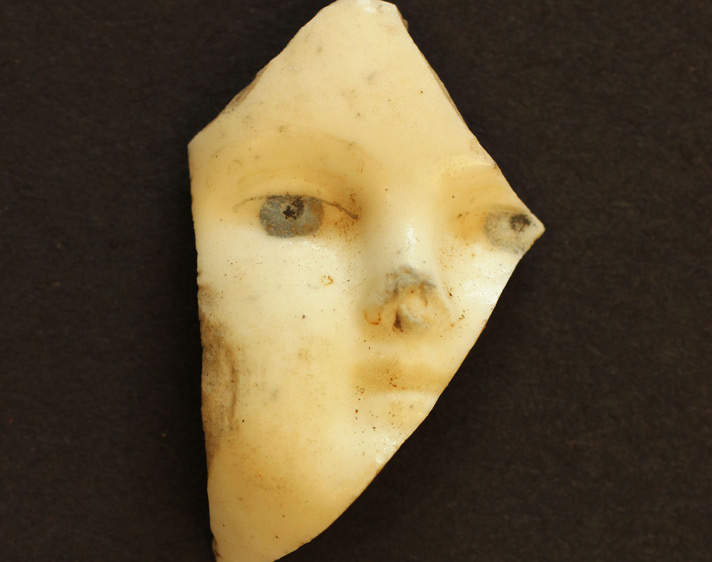Digging Jacksonville – April 2017
When the City of Jacksonville and the Oregon Department of Transportation uncovered a pile of horseshoes while transplanting a tree along C Street in 2010, they unexpectedly uncovered the remains of one of the town’s earliest blacksmith shops. Subsequent excavations by the Southern Oregon Laboratory of Anthropology (SOULA) revealed a variety of tools and other items that showed the site was once an active workshop serving the needs of a bustling frontier mining town. One artifact flew under the radar however; a small fragment of a bisque porcelain doll face found among the rust and broken glass. While it might seem like a minor out-of-place find, it shows that alongside the day to day work of the blacksmith, children would have been playing not too far away, and the town would have been alive with a variety of activity. Perhaps it was someone’s favorite toy that they lost one day, destined to be buried for years before we uncovered it.
I know that when I was a kid, my toys often had lives of their own. Most of them had names and recited heroic phrases and insults at one another while they fought in the battlefield I created for them in the yard. I imagine that I was not the first child to occupy themselves in such a way, and looking at the blank stare of the doll’s face makes me wonder if it had a name, and whether or not it once said things to the kid it belonged to. A toy like this seems like a more personal object than the rusty tools and horseshoes it was found alongside, and it is sad to think what someone must have felt when they lost or broke the doll.
So how did the doll end up here? Maybe the doll belonged to one of the blacksmith’s children. A number of smiths are listed on Jacksonville’s 1860 and 1870 census, and although we don’t know who worked at this particular shop, speculation is free. Many of them had families they were providing for, and it wouldn’t be too far-fetched to think this doll could have belonged to one of their daughters. Perhaps it was ten-year-old Mary Mickelson’s, who was the first of her family born in Oregon; the two blacksmith’s she lived with, presumably her father and brother, were both from Norway. Or perhaps the doll was a memento belonging to one of the smiths themselves. Perhaps it once belonged to a sister or a daughter who was lost during the difficult journey west, and kept to remember them by. It is just as easy to imagine a horseshoeing gone awry, an animal knocking over a shelf, sending the toy into the dust and the blacksmith cursing while picking up the pieces—missing one of course—as it is to imagine a kid accidently dropping their favorite plaything when they snuck it outside against their parents’ wishes. After all, such dolls were not cheap.
While we will likely never know the answer, it is sometimes useful to stop and look at things differently. The artifacts we study don’t tell us every secret they have, and I think that can be for the best. The past is full of untold stories and even adults need to remember how to use their imagination every once in a while.

 Kyle Crebbin received his B.S. in Anthropology from SOU, and is working with SOULA until he begins graduate school at the University of Nevada, Reno next fall 2017. You can reach SOULA by contacting Chelsea Rose at rosec@sou.edu and follow SOULA on
Kyle Crebbin received his B.S. in Anthropology from SOU, and is working with SOULA until he begins graduate school at the University of Nevada, Reno next fall 2017. You can reach SOULA by contacting Chelsea Rose at rosec@sou.edu and follow SOULA on